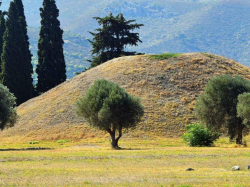Archaeological Site of Marathon

Archaeological Site of Marathon
The burial site of Hellenic soldiers who fell in the epoch-making Battle of Marathona, protecting Athenian civilization from Persian conquest in 490 B. C., was excavated by Greek archeologists in 1970. The mass grave contains 192 skeletons of young soldiers slain in the battle between East and West 2,460 years ago.
The tomb pays homage to the warriors who had volunteered to help the Athenian Army under the leadership of Miltiades to fight the Persian invaders, though heavily outnumbered by the enemy. Reports differ, but there is a widespread acknowledgment that the battle resulted in a significant number of Persian fatalities, with many more put to flight. This conflict would signal the last time a Persian army invaded mainland Greece. The mass grave lays under carefully built stone tumulus or burial mound, 10 ft high and 50 ft in diameter, its edge marked by hewn stones, on a plain 26 miles northeast of Athens.
The excellent Marathona museum is several miles from the battlefield but is signposted both there and on the main road.








